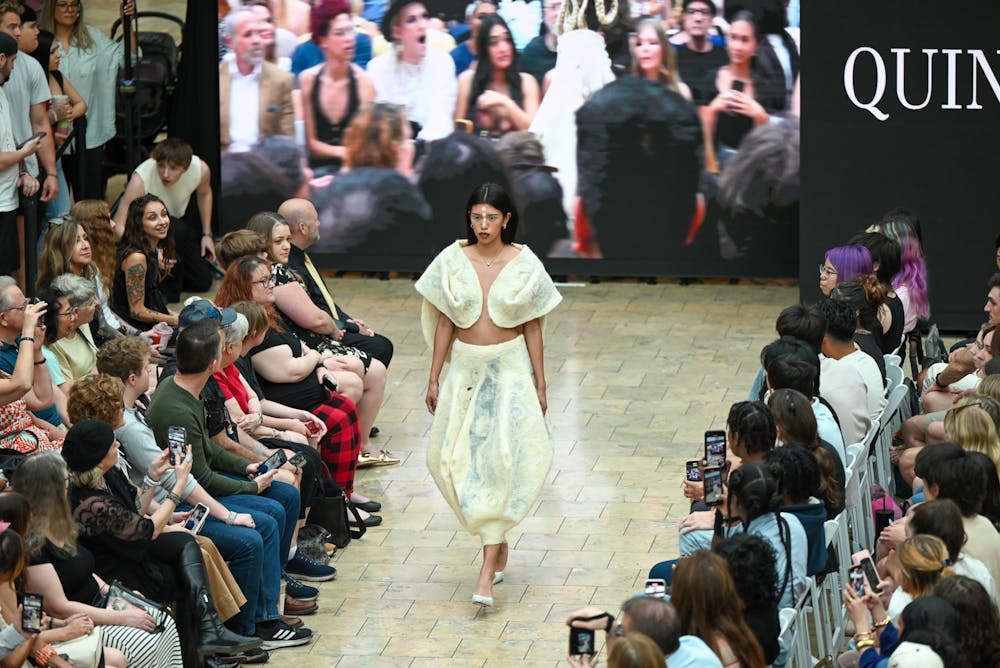Backstage at ASU's Fashion Institute of Design and Merchandising "Uncertainty Fashion Showcase," the air buzzed with anticipation — and stress. Steamers hissed over last-minute wrinkles, sewing needles raced through final stitches and dresses flew out of garment bags.
The dressing rooms had become the chiffon trenches as models teetered in six-inch heels while threading through tight corridors packed with racks of gowns. The buzz of suspense was only matched by the buzz of DJ Mucci's set.
Designers shouted over each other to locate safety pins, fashion tape and one elusive left shoe. Amid the barely contained chaos, there was a sense of greater purpose. These weren't just clothes, but statements. Every look hitting the runway represented months of sleepless nights and creative risks.
"This is how fashion is going to end up looking in the next several years," said Alexander Diesner, a senior studying fashion.
Diesner's work is just one example of how ASU FIDM's senior class is pushing the boundary of how fashion is perceived. His collection, inspired by fabric degradation and conservation, showcased meticulous knitting techniques giving traditional loungewear textiles an evening wear flare while showcasing bespoke corsetry and knitted bodysuits adorned with lace.
Many designers used their collections to explore deeply personal themes. Olivia Nichols' collection 'Revolution!' tackled class disparity through the symbolism of leather, cogs and 18th-century silhouettes.
"I just know I want every collection I do to represent my ideas of furthering society," Nichols, a senior studying fashion, said. "This one in particular was my representation of the cultural zeitgeist of now."
Similarly, Kaitlyn Tracy, a senior studying fashion, turned to Dante's "Divine Comedy" after the loss of her father, translating grief and healing into her artistic journey. Her collection "The Divine Journey" draws from painting and religious iconography.
"Clothing to me is so much more than just another art form," Tracy said. "It's another way to paint. It's another way to express (myself)."
For Christian Reid Miron, a senior studying fashion, literature was his main source of inspiration as he looked toward author Vladimir Nabokov for his collection. His final piece, a fully crocheted dress, captured the hours of behind-the-scenes work and authenticity that designers invested into their capstones.
"I really wanted my capstone to be the one true form of self-expression I can make," Reid Miron said. "I don't know when I'll be able to actually have full creativity out of something I can make that gets viewed. So I really wanted to try to be as authentic to my art style and to what I find interesting."
Designers like Atticus Doan, a senior studying business sustainability, whose menswear collection reimagined 1920s workwear through a lens of sustainability and gender fluidity, opened the sustainability conversation to include slow-production garments.
"I didn't want to participate in the production of new fabric when there's so much already available," Doan said.
With deadstock wool and rayon, his garments reject polyester and corporate production altogether.
Uncertainty was not without its collection of themes, with other students focusing their own heritage and identities in their collections. Designer Sean Schuljak, a recent ASU graduate who studied theater acting and fashion design, merged ballroom culture with heavy metal to create his collection titled "Glam and Grit," a tribute to queer expression.
"I want to create performance wear … something very Met Gala worthy," Schuljak said, who also performs in drag as "Lady Fall."
Berenice Calixto Castillo, a senior studying fashion, honored her Chicana and Mexican roots by combining colonial silhouettes with modern streetwear, adding airbrushed textiles and piercing motifs inspired by Monterrey's Kolombia subculture.
"I saw how eclectic and bold the fashion was," Calixto Castillo said. "I wanted to play on that with the way I used colors and my own culture."
For Alyssa Baca, a senior studying fashion, childhood nostalgia was the muse. Her pastel collection reflected both fear and excitement about adulthood, realized through childlike silhouettes and laser-etched denim.
"I hope (my collection) opens doors for me after and gets that exposure out there," Baca said.
From social commentary to environmental advocacy, ASU FIDM's 2025 Capstone designers aren't just predicting the future of fashion — they're creating it. The program's commitment to forward-thinking education is clear, as students graduate not only with a portfolio but with a purpose and the skills to challenge the fashion industry.
The runway may have ended on Saturday, but for these designers, their journey in fashion is just beginning.
Edited by Andrew Dirst, Abigail Beck and Natalia Jarrett.
Reach the reporter at thutche1@asu.edu.
Like The State Press on Facebook and follow @statepress on X.
Tiffany is a freshman studying fashion design in business administration. This is her second semester with The State Press.




